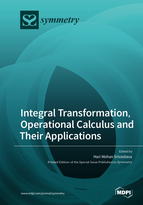Integral Transformation, Operational Calculus and Their Applications
A special issue of Symmetry (ISSN 2073-8994). This special issue belongs to the section "Mathematics".
Deadline for manuscript submissions: closed (31 March 2022) | Viewed by 20182
Special Issue Editor
Interests: real and complex analysis; fractional calculus and its applications; integral equations and transforms; higher transcendental functions and their applications; q-series and q-polynomials; analytic number theory; analytic and geometric Inequalities; probability and statistics; inventory modeling and optimization
Special Issues, Collections and Topics in MDPI journals
Special Issue Information
Dear Colleagues,
The theory and applications of integral transformations and associated operational calculus are remarkably wide-spread in many diverse areas of the mathematical, physical, chemical, engineering and statistical sciences. In this Special Issue, we invite and welcome review, expository and original research articles dealing with the recent advances on the topics of integral transformations and operational calculus as well as their multidisciplinary applications involving their symmetry properties and characteristics.
Prof. H. M. Srivastava
Guest Editor
Manuscript Submission Information
Manuscripts should be submitted online at www.mdpi.com by registering and logging in to this website. Once you are registered, click here to go to the submission form. Manuscripts can be submitted until the deadline. All submissions that pass pre-check are peer-reviewed. Accepted papers will be published continuously in the journal (as soon as accepted) and will be listed together on the special issue website. Research articles, review articles as well as short communications are invited. For planned papers, a title and short abstract (about 100 words) can be sent to the Editorial Office for announcement on this website.
Submitted manuscripts should not have been published previously, nor be under consideration for publication elsewhere (except conference proceedings papers). All manuscripts are thoroughly refereed through a single-blind peer-review process. A guide for authors and other relevant information for submission of manuscripts is available on the Instructions for Authors page. Symmetry is an international peer-reviewed open access monthly journal published by MDPI.
Please visit the Instructions for Authors page before submitting a manuscript. The Article Processing Charge (APC) for publication in this open access journal is 2400 CHF (Swiss Francs). Submitted papers should be well formatted and use good English. Authors may use MDPI's English editing service prior to publication or during author revisions.
Keywords
- Integral Transformations and Integral Equations as well as Other Related Operators Including Their Symmetry Properties and Characteristics
- Applications Involving Mathematical (or Higher Transcendental) Functions Including Their Symmetry Properties and Characteristics
- Applications Involving Fractional-Order Differential and Differintegral Equations and Their Associated Symmetry
- Applications Involving Symmetrical Aspect of Geometric Function Theory of Complex Analysis
- Applications Involving q-Series and q-Polynomials and Their Associated Symmetry
- Applications Involving Special Functions of Mathematical Physics and Applied Mathematics and Their Symmetrical Aspect
- Applications Involving Analytic Number Theory and Symmetry






